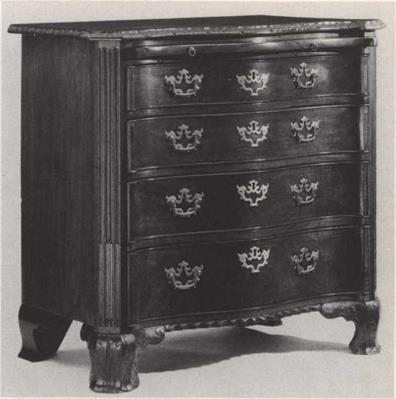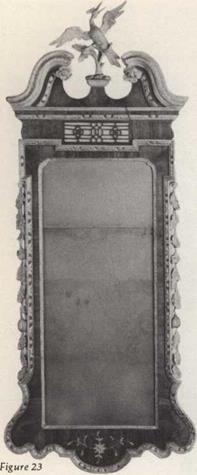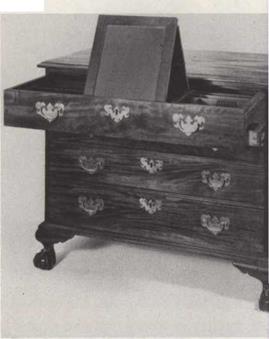
 Chests of Drawers. For case furniture, cabinetmakers determined their price partially on the number of drawers to be fashioned. It follows that the most popular storage form of the period was the chest of drawers. Thick, square feet, and deeply notched, cyma-curved "swelled brackets" virtually identical, characterize Figures 15 and 16. The top drawer of Figure 15 is fitted with compartments to hold necessities for the toilet of an 18th – century gentleman.
Chests of Drawers. For case furniture, cabinetmakers determined their price partially on the number of drawers to be fashioned. It follows that the most popular storage form of the period was the chest of drawers. Thick, square feet, and deeply notched, cyma-curved "swelled brackets" virtually identical, characterize Figures 15 and 16. The top drawer of Figure 15 is fitted with compartments to hold necessities for the toilet of an 18th – century gentleman.
"Dressing chests" were advertised for sale in New York City in 1773. It seems an appropriate name for this form. Of three similar examples, two bear the label of Samuel Prince, who kept a cabinet shop at the "Sign of the Chest of Drawers" in New York City.2 Figure 17 reveals (all at extra cost) stop fluting (see PI. I;
Fig. 7), leaf-and-dart carving on the ogee-shaped edge of its top, leaf carving on its bracket feet, a writing slide, and serpentine front. It is not surprising, then, to find the Van Rensselaer name inscribed back of the writing slide.
Fig. 15: mahogany, tulip;
1770-80; H 32 W (81.9 cm); acc. no. G52.143. Fig. 16: mahogany, tulip; 1765-80;
H 33 ‘k" (84.4 cm); acc. no. C58.1787. Fig. 17: mahogany, tulip; 1765-80; H 33" (83.8 cm); acc. no. C54.86.
|
Figure 17 |
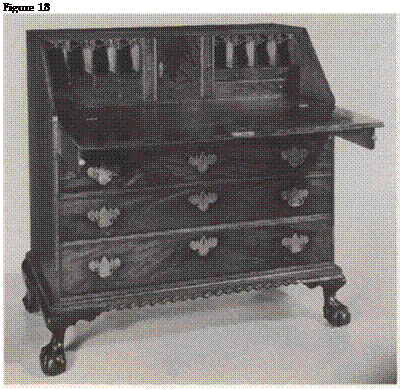 |
Figure 18. Desk. New York cabinetmakers preferred straight, unadorned lines for desks as well as chests of drawers. Carved gadrooning often relieved the horizontal thrust of their plain fronts. Many New York desks were made with claw-and-ball feet at the front, and heavy, ogee-bracket feet supporting the rear corners—a characteristic shared with Rhode Island and Connecticut furniture. Plain desks probably cost three to four times as much as chests of drawers. The investment was considered practical by many people because a desk provided storage, a degree of security for valuable papers, and surfaces ■ to be used to carry on correspondence. Fig. 18: mahogany, tulip; 1765-80; H 45" (114.2 cm); acc. no. C58.1786.
Figure 19. Desk and Bookcase. Thomas Chippendale and his contemporaries referred to this form as a desk and bookcase. It was one of the most expensive case pieces available in the 18th century. Few were made with glazed doors in the colonies.
Cornice, central door, and pigeonholes of the desk section, and brasses all reflect a blind or pierced fret in a diamond and saltire design. Its “swelled" bracket feet are decorated with C-scrolls and acanthus-leaf carving.
A design for a pediment bookcase in Household Furniture in Genteel Taste for the Year 1760 served as its source. On the basis of a similar desk and bookcase bearing Samuel Prince’s label, Figure 19 is attributed to his shop.
Fig. 19: mahogany, tulip, white pine; 1770-75; H 98>A" (250.2 cm); асе. no. C51.31.
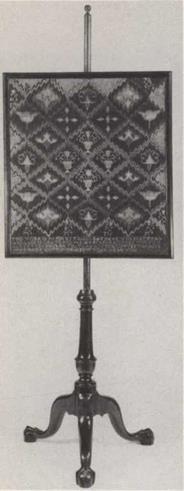
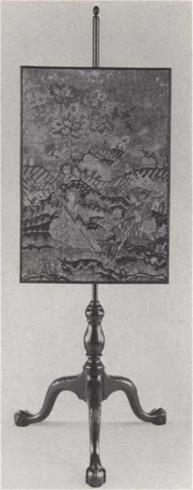
Figures 20 and 21. Fire Screens. Without such evidence as the panel on Figure 20 (by Tanneke Pears "in newyohk yeah 1766") it is difficult to relate fire screens to a school of cabinetmaking. But some clues are usually present. An urn and Tuscan or Doric columnar shaft (Fig. 20) relate to two New York candlestands (Figs. 26, 27), a tea table, and a New York fire screen.3 The baluster shaft and shallow New York-type carving on the knees of Figure 21 are identical to those on a New York tripod-base tea table at the Albany Institute. (See also Fig. 25; PI. IV). Fig. 20: mahogany; dated 1766; H 595/e" (151.4 cm); асе. no. C65.2903. Fig. 21: mahogany; 1760-75; H 614" (155.6 cm); асе. no. C58.1788.
Figure 22. Looking Glass. Figure 22 is a fine example of one type of looking glass known to have been used in New York. During the Chippendale period, New Yorkers were told that they could purchase looking glasses imported from London in frames or that frames "in the most elegant and newest fashion" could be carved for them in their city.
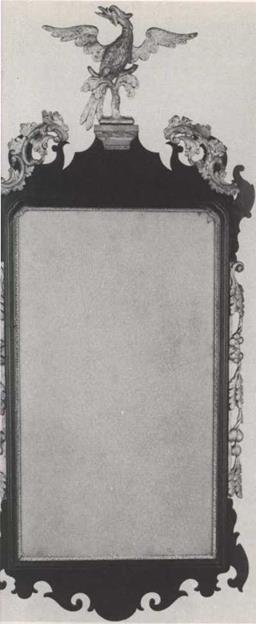 At present it is thought that the basic mahogany veneer on spruce frame is English and the carved white pine and tulip gilt ornaments were added in New York. The C-scroll and leaf carving applied to its crest; and pendant fruit, leaves, and flowers at its sides, signified recognition of the "modern taste." Fig. 22: mahogany veneer on spruce, white pine, tulip; 1775-90; H 513A" (131.4 cm); acc. no. G59.795.
At present it is thought that the basic mahogany veneer on spruce frame is English and the carved white pine and tulip gilt ornaments were added in New York. The C-scroll and leaf carving applied to its crest; and pendant fruit, leaves, and flowers at its sides, signified recognition of the "modern taste." Fig. 22: mahogany veneer on spruce, white pine, tulip; 1775-90; H 513A" (131.4 cm); acc. no. G59.795.
|
|
Figures 23 and 24. Looking Classes. A simpler version of Figure 23, in the Albany institute of History and Art, bears the stamp of its owner, Philip Van Rensselaer. In 1794, Winterthur’s example was presented by Martha Washington to the wife of John E. Van Alen, congressman from Rensselaer County, N. Y. It has a white pine backboard and carved phoenix with mahogany veneer over an English spruce frame. Figure 24 was originally in the Imlay House, Allentown, N. J. Its construction of walnut veneer over spruce and Scots pine carvings indicate that it was imported from England. Fig. 23: mahogany veneer over spruce, white pine; 1755-90; H 61Vt" (155.6 cm); асе. no. C58.2142. Fig. 24: walnut veneer over spruce, Scots pine; 1755-90; H 69" (175.2 cm); one of a pair; acc. no. G57.664.1.
|
|
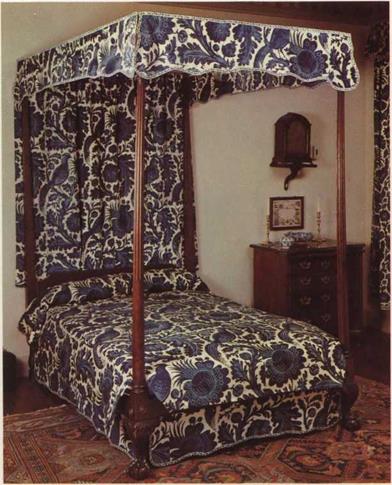
Plate 1. Bed. In colonial America, the term bedstead meant the frame, headboard, and posts. Bed furniture referred to matched hangings, as in this set of English indigo resist-dyed cotton. The bed has typical New York cabriole legs with leaf-carved knees and square claw-and-ball feet. Other New York examples have stop fluting (Figs. 7,17). The rear posts, usually plain and covered by a side curtain, are here tapered and end in turned balusters supported by pedestal bases. PI. 1: mahogany; 1760-75; H 87" (221 cm); acc. no. G55.799.
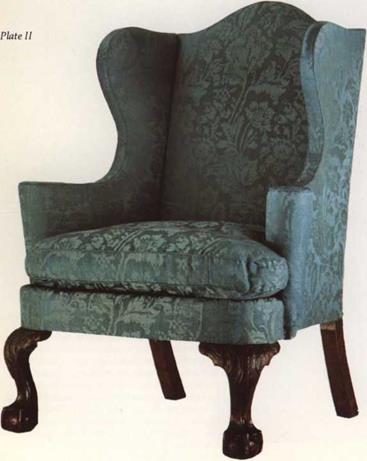 |
Plate II. Easy Chair. The blue upholstery (1750-70) of this New York chair is appropriate because New York newspapers indicate that English silk damasks were sold there by upholsterers. However, the fabric would usually have been wool worsted damask or printed cotton. New York upholsterers used brassheaded nails to finish furniture. In 1762, lightning, coming down the chimney of a house, ran along “the Brass Nails that was in a Settee near the Hearth, blackening the Heads of all of them."4 Massive looking, only the leaf-carved knees of this chair reflect the "modern taste." PI. П: mahogany; 1760-75; H 46" (116.8 cm); асе. no. C57.533.
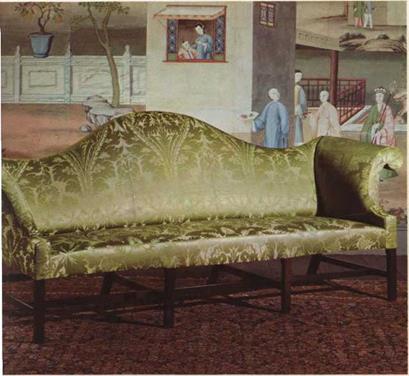
Plate 111. Sofa. John Brinner, a New York cabinet – and chairmaker from London, indicated in 1762 that he made sofa, couch, and easy chair frames. John Brewer, an upholsterer in the same city, stuffed and covered the same forms.5 Л plain Marlborough-legged sofa frame, with plain stretchers, cost little more than a walnut chest of drawers, but"Stuffing and covering" added considerably to its expense. A New York serpentine back sofa with similar scrolled arms and rectangular stretchers is owned by the Henry Ford Museum. Some Rhode Island sofas of this period are similar, but microanalysis of its structure, covered in French green and white silk lampas (ca. 1750), indicates that it was made in New York. PI. Ill: mahogany, American beech, red gum, yellow pine; 1770-80; L 105(268.6 cm); acc. no. G51.6.

